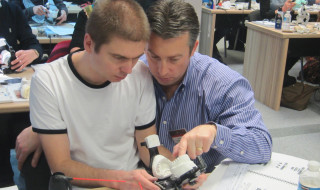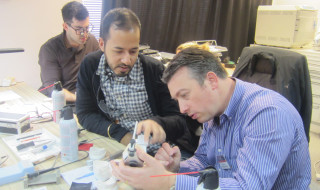 Neil Harris explains how the Dawson Academy helped him to have his lightbulb moment.
Neil Harris explains how the Dawson Academy helped him to have his lightbulb moment.
Throughout dental school we were taught many things that are no longer of relevance to our day to day lives working in a general dental practice. All the names of the bacteria that exist in a periodontal pocket, a classification for all the cysts of dental origin or the neural pathology of pain; and many more things that I have forgotten with the passing of the 20 years since I graduated.
In those 20 years I have found the area of dentistry that I have a passion for – cosmetic dentistry. I learned the different aspects of smile design, the different types of veneer preparation, the best adhesives, how to develop beautiful layered composites, etc. I’ve also learned a lot about orthodontics and implant dentistry.
Given how many courses I have undertaken it still amazes me that nobody explained to me, at any point during my dental career, the fundamental relationship between the teeth, muscles and jaws, and the effect that this has on the patient’s well being and the longevity of our dentistry.
The lightbulb moment
It wasn’t until I spent time at the Dawson Academy UK, with Dr Ian Buckle and Dr DeWitt Wilkerson, in 2010 that the mechanics of the jaws were explained, and how this ‘TMJ-occlusal system’ affected all parts of dentistry.
They helped me fit all the pieces of the jigsaw puzzle together into a defined, structured learning pathway that I could take back to my practice. This was the glue that fitted the restorative dentistry, orthodontic treatments and implant dentistry into a cohesive treatment regime. The Dawson systems ensured that when any patient approached me I could deliver ideal functional and aesthetic dentistry that I knew would last.
The Dawson Academy separates its courses into four modules, which gradually build to give you the full picture of ‘complete dentistry’.
I remember being sat in a class of 20 people, in the comprehensive examination and records module, with Dr Buckle describing the relationship between the teeth, jaws and muscles when suddenly everything I had learned in the last two decades suddenly fitted into place – what I always describe as my lightbulb moment!
The Dawson Academy
 Throughout the weekend course I was shown techniques that allow you to accurately record the elusive point know as centric relation, and ensure that all the information I recorded at the examination would allow me to go on and deal with all of the issues diagnosed; even in the most complicated cases.
Throughout the weekend course I was shown techniques that allow you to accurately record the elusive point know as centric relation, and ensure that all the information I recorded at the examination would allow me to go on and deal with all of the issues diagnosed; even in the most complicated cases.
It also left me knowing I was on the cusp of discovering how to develop and formulate treatment plans for my patients that could solve many of the problems seen day to day, such as tooth wear, why teeth break, why jaw joints click and when this is serious. I couldn’t wait to get back and learn more!
During the following module I learned how to develop the skills to treatment plan every case using the Dawson systems (treatment planning module). The systems are designed to ensure that a treatment plan is developed to deliver optimum outcomes from functional, aesthetic, biological and structural perspectives. This is what is termed comprehensive dentistry, and the outcome means that the dentistry will look fantastic, function in harmony with the patient’s needs and put your dentistry under as little stress as possible.
The following module covered the dark art of equilibration (equilibration module), along with splint therapy. By the end of this weekend we had a full understanding of all the different types of splint to use and the clinical situations where they are best used. Dr Buckle also managed to explain equilibration to all the students on the course, which allowed us to complete a trial equilibration on models.
The final course showed us how to prepare teeth for veneers, crowns and direct composites using modern minimal preparation designs (restoring anterior teeth module). With the increasing number of wear and erosion cases walking into practices, being able to restore anterior teeth in a minimally invasive way is an essential tool to have.
There is also a lot of time spent on the design of provisional restorations so that you can be sure that the final prostheses are perfect for function, aesthetics and phonetics.
Providing solutions
Because of the Dawson UK courses my practising life has changed, allowing me to understand my patients’ problems on a much higher level, and provide them with solutions that will work for the long term.
Most importantly the relationship doesn’t end the moment you leave the building; the team at the Dawson Academy UK are also on hand to mentor you after the course and help you start developing the systems within your practice.
If you really want to help your patients, practice better dentistry and have more successful dentistry then The Dawson Academy UK is the place to start.
To find out more information visit www.bdseminars.com.


